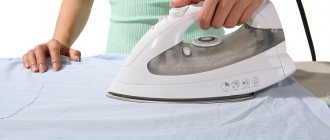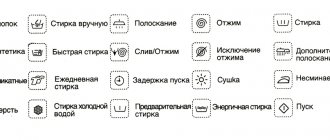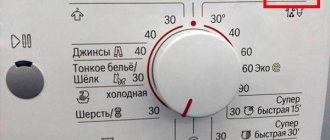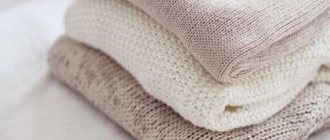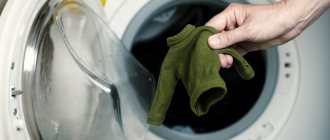Do you think cotton shrinks after washing? You are probably confidently shaking your head, because even our grandmothers knew that this fabric is not subject to shrinkage, and therefore, every weekend they selflessly boiled bed linen and diapers in huge enamel buckets. Who had wooden tongs at home for boiling linen and clothes?
No one over 35 is now surprised. However, is it really that simple? Does cotton shrink, for example, when washed at 90 degrees? Let's look at this issue in detail!
Preparing cotton items for washing
If a large number of cotton items have accumulated in the basket, first of all, they need to be sorted.
First, you should separate white, colored and black laundry. You can’t wash it together, because as a result, white will at best become gray, and colored will change color.
Light-colored products are sorted in 2 stages:
- Separate laundry that only needs to be refreshed from heavily soiled and stained laundry.
- Based on the label, items made from mixed fibers, as well as delicate, terry, and lint items are put aside.
Colored models are classified according to composition and color strength. Black clothes are washed only with dark colored items.
New denim items, as well as coats and jackets, for example: diagonal, moleskin, corduroy, are cleaned by hand or in a washing machine only on an individual basis.
After sorting, the following manipulations are performed with things:
- Outerwear with zippers and buttons is fastened and turned inside out.
- Pillowcases and duvet covers are also turned inside out and loose fluff and dirt are removed from their seams.
- Dust is shaken out of velvet and velor jackets, covers, and curtains, as they tend to attract large quantities of it.
Properties of cotton fabrics
Before talking about whether cotton shrinks in hot water, it’s worth talking about the properties of this material. Products made from this fabric are very durable and last a long time. Air penetrates well through the fabric due to the natural nature of the fiber. You can wash things made from this material at temperatures up to 40 degrees, but there are still disadvantages to this fabric:
- it wrinkles a lot;
- takes a long time to dry;
- may take on a yellowish tint when exposed to sunlight;
- shrinks during washing.
Cotton has these main disadvantages. Therefore, despite its lightness and good quality, not every woman will decide to buy a product made from this particular material. It's not entirely practical to use. It is because of such disadvantages that many consider cotton products capricious and refuse to purchase them. The main question when purchasing is: does cotton shrink after washing? Since the most important reason for refusing to purchase is the deformation of the product during this process.
Soak
Heavily soiled cotton items require soaking before the main wash. For wardrobe items and curtains made of openwork and thin fabrics, it is better to choose a liquid or gel when soaking. After drying, they will not leave streaks on the surface.
White cotton models are pre-treated as follows:
- Things are immersed in clean water for 2-3 hours. Then they are wrung out. Soaking is carried out only at room temperature. Hot water will further embed dirt and possible stains into the fibers.
- Soda (table or soda ash) is dissolved in a glass of hot water and poured into a washing container (1-2 tablespoons of the substance are required for 10 liters of water). The laundry is kept in the solution for half an hour.
- Rub a quarter of a bar of laundry soap into a separate bowl or pour 2 tbsp. l. washing powder for white fabrics. The detergent is thoroughly diluted with hot water and added to the container with laundry. Things should remain in this composition for another 2-2.5 hours.
- The products are pressed again and a decision is made on their further processing.
For tulle and muslin curtains (with the exception of kitchen ones), this procedure is sufficient, and all that remains is to rinse them.
Socks are soaked separately from other items, having previously been rubbed on the inside with laundry soap. Used handkerchiefs and models with embroidery are also pre-washed in the container. They are soaked in a slightly warm saline solution (30 g per 1 liter), and then the main wash is done in it.
This may be useful: How to whiten socks.
Colored cotton clothes are soaked in warm water with a special detergent. You should not use laundry soap, as the alkali it contains can cause the fabric to fade. To prevent hardness salts from damaging the color, soften the water with baking soda or ammonia (1 tsp per 5 l). The soaking time for dyed fabric ranges from 15 to 30 minutes. The more a thing sheds, the shorter the time period should be .
It is not recommended to immerse knitted fabric and velvet in water for a long time. Therefore, such things do not need pre-washing at all.
When first processing chintz and denim, add 3 tbsp to the water. l. salt or 5-6 tbsp. l. 9% vinegar per 10 liters. This will minimize shedding if the jeans are dyed.
Choosing Cotton Washing Products
When choosing powders and gels used for washing cotton, you need to pay attention to what kind of fabrics they are intended for - white, black, colored. It is better to choose powder with enzymes. They cope well with organic contaminants at water temperatures up to +60°C.
To wash children's pants and cotton shirts, you must use a powder specially created for this purpose with o.
Do not use bleaches containing chlorine. They thin the fibers of the fabric, which reduces its wear resistance. It is better to use oxygen bleaches.
If you care for cotton clothes correctly, they will neither stretch nor shrink. The main thing is to follow the regime of washing and drying items, use detergents suitable for this type of material, do not use chlorine bleaches, and your favorite things will delight you with softness and cleanliness for a long time.
Stain removal and whitening
Before the main wash, stains are removed from cotton fabric and the lost whiteness is restored to light-colored items. This can be done using a universal ready-made stain remover or folk remedies, after preliminary testing them on an inconspicuous area of the item. The cleaning method in the second case depends on the color of the fabric and the type of contamination.
- Oil stains from colored surfaces are removed with gasoline, acetone or turpentine, as well as soap alcohol (a solution of soap in wine alcohol). Light-colored items are cleaned with a paste of gasoline and crushed chalk. It is applied to the stain in a thick layer, and after a few hours it is cleaned off. If the result is unsatisfactory, the procedure is repeated 2-3 times.
- Remove traces of sweat from painted canvases with an aqueous solution of ammonia and rock salt (1 tsp per 200 ml). White things are saved with peroxide mixed with water in a ratio of 1:10.
- Streaks from a felt-tip pen, marker or ballpoint pen from colored wardrobe items are washed off with denatured alcohol diluted with water 1:10, and from white ones - with a heated aqueous solution of citric acid (10 g per 200 ml).
- Traces of fruit juice are removed from white fabric with citric acid mixed with wine alcohol (1:10 ratio) or water, as is the case with felt-tip pen stains. Colored fabrics are treated with heated glycerin or its mixture with chicken yolk. The composition is applied to the area of contamination, and after a few hours it is cleaned off.
After using any of these products, the stain is treated with clean water locally, and then the cotton item is washed completely.
Gray or yellowed fabrics can be revived by soaking in industrial bleach or one of the following solutions:
- 2 tbsp. l. table salt per 10 liters of water;
- 1 tbsp. l. ammonia and 2 tbsp. l. 3% peroxide per 10 liters of water. Processing time – 15-30 minutes with occasional stirring.
If linen with a 100% cotton composition needs to be not only bleached, but also disinfected, use the boiling method for half an hour. In this case, you can add to the water:
- grated laundry soap and 1 tbsp. l. ammonia;
- 2 tbsp. l. salt and soda, as well as washing powder with a bleaching effect;
- 3 tbsp. l. washing powder and 2 tbsp. l. "Whiteness."
We wash things by hand
Does cotton shrink after hand washing? Items made from fine fabrics are best washed by hand. When washing for the first time, you need to do this to know whether the item will fade or not. Even gentle washing in a machine can cause it to become deformed, which hand washing will not do.
The ideal washing option is a soap solution and water at a temperature not exceeding 40 °C. Laundry soap will be enough. It washes well and does not cause allergic reactions. You can, of course, use washing powder, but only one that is suitable for cotton.
Handwash
Pre-treated bed linen and wardrobe items made from durable fabrics are usually finished off in the washing machine. But for delicate fabrics (cambric, guipure, taffeta), as well as highly shedding material, for example: chintz, only hand washing is recommended. Thin fabrics are manually processed as follows:
- Any 100% cotton, and especially delicate fabric, tends to shrink when exposed to high temperatures. Therefore, water is poured into the washing container no hotter than 40°.
- A detergent is diluted in a basin, the choice of which depends on the color of the product. To improve the quality of washing white clothes, oxygen bleach is added to it; for colored clothes, table salt is added.
- When washing delicate cotton, do not rub it too hard, otherwise the fabric will become thin and may tear. It is also prohibited to twist clean models during spinning.
- Cotton items are rinsed thoroughly, changing the water several times. During the final rinse of colored fabrics, dilute 9% vinegar in a basin (1 teaspoon per 10 liters) to refresh the color.
Corduroy is washed in a special way. Semi-velvet is not completely immersed in water, but is cleaned with a brush, laid out on a hard horizontal surface. After treatment, the detergent is removed with a sponge soaked in clean water.
What kind of material is this?
To understand how cotton behaves after washing, let’s find out what kind of material it is.
- This is the most popular fabric in the world; it has an abbreviated version of the name - cotton;
- The material belongs to the category of natural, cotton thread is made from cotton fruits;
- 100% cotton is not elastic, does not shine, wrinkles a lot, instantly absorbs moisture, takes a long time to dry;
- Cotton fiber has a fluffy structure, and the resulting threads look slightly loose.
In the washing machine
Washing in an automatic machine will be successful if you follow these tips:
First of all, you need to decide at what temperature to wash a particular item. A corresponding mark on the label will help with this. If it is lost, you can navigate like this:
- Bed linen, blouses and shirts made of white satin, percale, poplin, calico are washed at temperatures from 60 to 90°. The more dirty the item is, the hotter the water should be.
- Tulle, mixed fabrics, for example: polycotton, terry items, brushed models, regardless of color, are cleaned at 40°.
- Colored cotton, depending on color fastness, can withstand heating in the range from 30 to 60°. In order not to make a mistake with the choice of temperature, you can test the strength of the dye. To do this, a piece of light cloth is moistened in a hot soapy solution and the material intended for cleaning is rubbed from the inside out. If spots appear on a light piece, select the minimum temperature.
If white items are slightly stained when a colored item of clothing accidentally gets into the drum, they are soaked in very hot water with the addition of soda for 12 hours. And then rinsed and washed again in the usual way.
Choosing a detergent. As with hand washing, cleaners are poured or poured into the machine’s ditch, depending on the color of the laundry. For white, additionally use bleach (not chlorine). For fabrics containing polyester, conditioner is required. For colored items, the latter can be replaced with 3-5 tbsp. l table vinegar.
The vast majority of natural fiber items are washed on the cotton or cotton express cycle. The exceptions are: denim, bike, frote (terry), flannel, veil. For them, select the “delicate wash” program and manually set the spin cycle to no more than 500 revolutions and additional rinse.
Automatic drying of cotton is undesirable, as it causes severe shrinkage. It is allowed to be used during the second and subsequent washes only for laundry that has a corresponding indication on the label.
You should not put natural fabric and synthetics into your car at the same time. Cotton items will become covered in pellets.
Durable, inexpensive and comfortable
Cotton is obtained from mature cotton fruits. The fabric is an interweaving of thin fluffy and soft fibers, slightly twisted around its own axis. The length of the raw material fibers largely determines the type of finished fabric. So, calico, chintz, flannel, cambric, poplin, twill, flannel, etc. have a cotton base.
Depending on the density of the material, they sew from it:
- summer clothes;
- underwear;
- jackets, trousers, skirts, dresses for cold weather;
- bedding, curtains, tablecloths and other household textiles.
@be_fahionable, @sartoria53, @beddingkatoon, @faby_d27
Properties of cotton fabric
It has both significant advantages and some disadvantages. However, knowing the basic rules of care and following them during operation, problems can be avoided.
Advantages of the material:
- Strength, lightness, softness.
- Hypoallergenic.
- Hygroscopicity.
- High degree of thermal insulation. A lot of air is retained between the numerous fibers, thanks to which the product retains body heat well.
- Affordability.
- Not damaged by insects.
Flaws:
- It gets dirty easily and doesn't wash well.
- Shrinks after washing.
- White things turn yellow over time.
Individual characteristics:
- dries slowly;
- easily wrinkles;
- has average abrasion resistance;
- lends itself well to painting.
What to do if cotton shrinks or stretches
Will cotton shrink after washing and how much? Most fabrics made from its fibers shrink on average by 1-3% in width and 4-6% in length (the exceptions are sateen and polycotton).
The opposite problem can arise after immersing knitted fabric in water - it not only shrinks, but also stretches. Is it possible to return damaged items to their original size? It is impossible to give a definite positive answer to this question, but it’s worth a try.
If the item shrinks, proceed as follows:
- Soak for two hours in water with oxygen bleach or peroxide. In the process, they try to stretch the model. Then it is rinsed and dried in a horizontal position.
- The damp fabric is ironed with a hot iron in the “steaming” mode. In this case, the product gradually stretches in the desired direction.
You can try to save stretched knitted clothing using one of the following methods:
- Place the model in a basin of hot (temperature 60-80°) water and hold it there until you can put your hand in the water. Wring out the item and place it in a container with cold water. After 10-15 minutes, the knitwear is wrung out again and, without straightening, placed on a terry towel spread on a horizontal surface to dry.
- Let the knitwear sit in water with a softener, and then, lightly wringing it out, dry it in the drum of the machine at maximum temperature.
Please remember that only certain things can be increased. You can't do anything with most items of clothing (blouse, trousers or jeans). You don’t even have to try to restore a stretched model if it contains polyester.
How to stretch
Cotton (especially the most natural) shrinks not very often, but it does happen. We will try to correct the situation, fortunately, there are methods.
Option one. Using a washing machine
To begin with, soak the item in cool water for a third of an hour. Next, machine wash with wool powder (or delicate wash). We need gentle washing, water – no higher than 30 degrees. The cotton will begin to stretch during the spin cycle, but we take it out of the machine damp, not wet.
Now we stretch the item and dry it on a hanger with a hanger. This can only be done in a vertical position. Don't forget to shake the cotton occasionally. You can also dry a wet dress or jacket directly on your body.
Option two
Peroxide is needed here. You need a couple of tablespoons per bucket of water. We simply rinse the fabric in it and sometimes gently pull it in several directions.
Instead of peroxide, a mixture of turpentine and vodka (a couple of tablespoons each), as well as ammonia (three times more than turpentine) in a bucket of water, is also suitable. Again, rinse and pull. Then keep it in this mixture for 90 minutes and then squeeze it out a little. We dry it on a wet towel, sometimes stretching it. You can also add vinegar to the rinse water.
Option three
We use an iron. Just put the thing that needs to be stretched a little on an ironing board covered with gauze and iron it, pressing hard. You can turn on steam if available. It is also recommended to put a thin cotton material or just gauze on top.
Which fabrics are most susceptible to shrinkage?
Fibers that shrink the most are those that can absorb the maximum amount of water and change their size when wet. Such fabrics include cotton and linen materials, as well as viscose. Woolen fabrics vary greatly in size. In this case, not only the diameter of the yarn changes, but also the structure of the fabric itself. Shrinkage during washing is also possible with corduroy and tartan, and fabrics such as chintz, cambric, poplin, teak, satin, calico and a number of others are less susceptible to shrinkage.
“Shrinkage greatly depends on the composition of the fabric, and it is not always possible to correct everything. The item can be corrected if it is wool that has a rough knit. Under steam, you can pull it a little and increase the product by one size. But there is such shrinkage that nothing can be corrected. This is the result of the wrong temperature being selected during washing. Nowadays, household machines have been improved; they have a delicate wash mode. Certain modes have a pre-programmed low temperature. You cannot act according to your own judgment or be in too much of a hurry when putting things away for washing. First of all, you need to read the labeling and see how to wash and dry things,” says dry cleaning manager Irina Yakush .
How does cotton differ from other materials?
The textile industry market is replete with a variety of materials. You can determine which material is better by studying the properties of each and comparing them with the characteristics of cotton fabrics.
How to distinguish cotton from synthetics
There are different types of synthetics, however, the properties of each type of synthetic materials are relatively the same. Synthetics, unlike cotton, do not wrinkle, do not allow moisture to pass through easily, and generate static electricity. If you can't figure out whether it's cotton or synthetic, look at the labeling. The presence of spandex, elastane or substances with the prefix “poly” indicates that it is synthetic. In addition, cotton materials can withstand high temperatures well, while synthetics can easily stick to the sole of the iron. If you burn a small piece of fabric, the synthetics will simply melt, and the cotton will burn and produce smoke with the smell of burnt paper.
The difference between the material and satin
Sateen is cotton, but only made by a special method of weaving the best and longest cotton fibers. Unlike natural cotton, satin has a characteristic shine on the surface. There are often cases when synthetic fibers are added to satin to increase the wear resistance and service life of the material.
The difference between cotton and calico
Calico is a type of cotton produced by plain weaving. The result is a fairly dense canvas with a matte surface. Calico is considered a lower quality material than cotton, withstands fewer washes, shrinks more often and quickly loses its color saturation.
The difference between cotton and cotton
Cotton is not a specific type of fabric, but just a name for cotton in English.
How to understand where is cotton and where is linen
Unlike cotton, linen is stiffer, stronger and attracts less dust. Linen items are warmer than cotton items. In appearance, linen has a little more shine than cotton. The material also wrinkles more and is difficult to smooth out. To learn how to determine in the future whether you are looking at cotton or linen, visit a fabric store and study both materials based on their external properties.
How is cotton different from poplin?
Both materials are made from natural cotton fibers, but differ greatly in appearance due to special processing and weaving of the threads. Poplin, unlike classic cotton, is more durable and reliable, but costs more.
The difference between fabric and viscose
Viscose is an artificial material made from wood cellulose. The fabric can consist of either 100% pure raw materials or contain additional artificial or natural fibers. In its pure form, viscose is used extremely rarely, as it suffers greatly from water and is not very durable. Most often, elastane, polyester or pure cotton fibers are added to the material. Viscose, unlike cotton, does not shrink, fades less in the sun, and holds its shape worse.
How to distinguish cotton from polycotton
Polycotton is a mixture of natural cotton fibers and polyester threads. Unlike cotton, polycotton is less pleasant to the body, less breathable and can cause skin reactions. However, products made from polycotton last longer, are more wear-resistant, practically do not wrinkle and are cheaper.
How to dry and iron correctly
The fiber has good light fastness, but it is better to hang it in the shade after washing. This will prevent the fabric from fading. But drying in the cold is beneficial for the fabric. Freezing water particles straighten the fibers, restoring airiness and softness.
A special drying mode in the washing machine can shrink things.
You can iron cotton without impurities at maximum temperature, with or without a steamer. It is better to iron various fabrics according to the rules for caring for additional fiber.
Ironing
Before ironing, be sure to check the material for stains; if you iron them out, they can settle firmly in the fibers and subsequently cannot be removed. Ironing items while slightly damp will help prevent creases and creases. If the fabric is still dry, spray the material with water during ironing or use a similar function on the iron.
For better smoothing, use the steam function, if available.
For large items such as duvet covers, sheets, curtains or tablecloths, first fold them several times and iron first on one side, then on the other, and so on. Repeat the manipulations until the product is completely ironed.
Shrinkage and its causes
If you are not careful when processing cotton fabrics (for example, chintz, cambric, satin and others), they can:
- sit down (be subject to deformation);
- turn yellow;
- shed.
The material shrinks both in length and width. In order to properly care for such fabrics, you need to understand why their size changes.
The reduction in the original size of cotton is largely due to the structure of the fibers. The raw material for the production of the material is the fluffy mass of cotton fruits.
Textile threads are thoroughly stretched during the manufacturing process. When in contact with water and heat treatment, cotton fabrics swell, and when dried, they change length (shrink).
If decating was carried out correctly during production, the scale of shrinkage is much less. Decatation is the processing of textiles (wet-thermal) during the production process. Its purpose is to pre-shrink fabrics before cutting them.
The reason for shrinkage of cotton fabrics is often the incorrectly chosen washing (ironing) temperature.
Artificial fabrics, as a rule, are not prone to shrinkage, which is why adding them to cotton makes it more stable and elastic. Cotton with elastane (satin, stretch cotton, bengalene, gabardine, polyester) has increased stretchability.
When fibers are combined, the texture of the fabric becomes elastic, firm, and shrinks to a lesser extent. However, we must not forget about the temperature compliance when washing and ironing, determined by the product labels.

